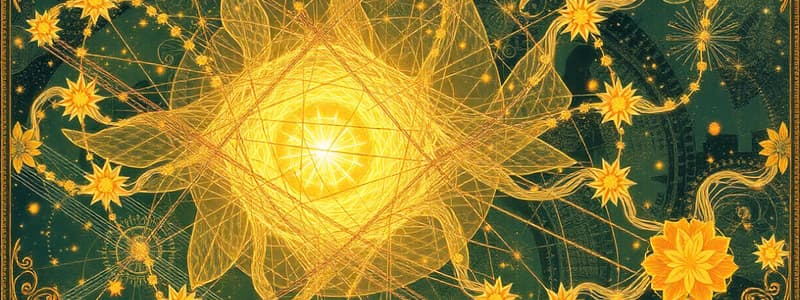Podcast
Questions and Answers
What is the main role of a selective agent in natural selection?
What is the main role of a selective agent in natural selection?
- To select characteristics that enhance survival (correct)
- To eliminate all competition in an ecosystem
- To artificially improve traits in a population
- To ensure all organisms in a population reproduce
Which sequence correctly identifies the three steps of speciation?
Which sequence correctly identifies the three steps of speciation?
- Variation, Selection, Isolation
- Variation, Isolation, Selection (correct)
- Selection, Variation, Isolation
- Isolation, Variation, Selection
What leads to genetic variation within a population?
What leads to genetic variation within a population?
- Environmental destruction
- Uniform breeding schedules
- Homosexual mating practices
- Crossing over during meiosis (correct)
Which factor can result in reproductive isolation?
Which factor can result in reproductive isolation?
Which statement best explains the principle of 'survival of the fittest'?
Which statement best explains the principle of 'survival of the fittest'?
What is artificial selection primarily used for?
What is artificial selection primarily used for?
Which type of evidence provides support for evolution through the remains or traces of past organisms?
Which type of evidence provides support for evolution through the remains or traces of past organisms?
What do homologous structures indicate about different species?
What do homologous structures indicate about different species?
How does comparative embryology provide evidence for evolution?
How does comparative embryology provide evidence for evolution?
Which statement about comparative DNA and protein structure is true?
Which statement about comparative DNA and protein structure is true?
What is the significance of geographical distribution in supporting evolution?
What is the significance of geographical distribution in supporting evolution?
What did the color variation in peppered moths during the Industrial Revolution demonstrate?
What did the color variation in peppered moths during the Industrial Revolution demonstrate?
Which of the following is NOT a form of evidence for evolution?
Which of the following is NOT a form of evidence for evolution?
What does Newton's First Law of Motion describe?
What does Newton's First Law of Motion describe?
Which equation represents Newton's Second Law of Motion?
Which equation represents Newton's Second Law of Motion?
How does mass affect an object's inertia?
How does mass affect an object's inertia?
What happens to gravitational potential energy when an object is lifted higher?
What happens to gravitational potential energy when an object is lifted higher?
What is the kinetic energy of a 1000kg car traveling at 5m/s?
What is the kinetic energy of a 1000kg car traveling at 5m/s?
Which concept is expressed by the Law of Conservation of Energy?
Which concept is expressed by the Law of Conservation of Energy?
What is the motion of an object experiencing unbalanced forces?
What is the motion of an object experiencing unbalanced forces?
Which of the following is an example of Newton's Third Law of Motion?
Which of the following is an example of Newton's Third Law of Motion?
What advantage does the sickle-cell allele provide in malaria-prone regions?
What advantage does the sickle-cell allele provide in malaria-prone regions?
How do homologous structures differ from analogous structures?
How do homologous structures differ from analogous structures?
What process involves humans selectively breeding animals for desirable traits?
What process involves humans selectively breeding animals for desirable traits?
What is an example of a vestigial structure in humans?
What is an example of a vestigial structure in humans?
What determines which phenotypes are favored by selection pressures?
What determines which phenotypes are favored by selection pressures?
Which of the following best describes the difference between natural selection and artificial selection?
Which of the following best describes the difference between natural selection and artificial selection?
Which inferences can be made about the black moth population during the Revolution?
Which inferences can be made about the black moth population during the Revolution?
Which statement is true regarding vestigial structures?
Which statement is true regarding vestigial structures?
Flashcards are hidden until you start studying
Study Notes
Newton's Laws of Motion
- First Law (Inertia): An object at rest stays at rest and an object in motion stays in motion at a constant velocity unless acted upon by an unbalanced force.
- Balanced Forces: Equal forces in opposite directions result in no motion or constant velocity.
- Unbalanced Forces: Unequal forces in opposite directions produce an unbalanced force causing acceleration.
- Inertia: A property of an object that describes its resistance to changes in its motion. More mass means more inertia.
- Second Law: Force equals mass times acceleration (F = ma).
- Third Law: For every action, there is an equal and opposite reaction.
- Example 1: When a gun is fired, the bullet moves forward, and the shooter is pushed backward with an equal force.
- Example 2: When you step off a boat, the boat pushes back, often causing you to fall in.
Energy - Kinetic and Potential Gravitational
- Kinetic Energy: The energy of motion. Anything moving has kinetic energy.
- Greater mass and speed = greater kinetic energy.
- Equation: KE = 0.5mv^2
- Gravitational Potential Energy (GPE): A type of stored energy associated with objects above the ground.
- On Earth, we always have the force of gravity acting upon us.
- When we're above the Earth's surface, we have GPE, potential (stored) energy.
- Depends on mass and height above the ground.
- Equation: PE = mgh
The Law of Conservation of Energy
- Energy cannot be destroyed or created, only transferred or transformed from one form to another.
- PE = KE (potential energy can be transformed into kinetic energy)
Evolution - Natural Selection
- Process: An environmental factor impacts populations.
- Selective agent: Selects the characteristic that will survive.
- Results: More or less offspring from particular organisms.
- Outcome: Organisms best suited to the environment survive and pass on their genes (survival of the fittest). Less adapted organisms produce less or not at all.
- Selective Agent: Can be a color of fur, trait, mutation, adaptation.
- Speciation: The process by which one species splits into two separate species.
- Three Steps:
- Variation
- Isolation
- Selection
- Three Steps:
Variation
- Natural selection depends on varying traits within a population.
- Genetic variation is caused by:
- Mutation
- Random mating/fertilization
- Crossing over in meiosis
- Variation provides options for the species when an environment changes.
- Individual organisms may be wiped out.
- Favourable adaptations survive and continue the species' gene pool.
Isolation/Selection
- When two populations of a species are separated, gene flow is stopped.
- Two species with different selection pressures become more different.
- Eventually, they may become incapable of interbreeding, becoming different species.
Reproductive Isolation
- Species might not be able to breed due to:
- Courtship behavior - new breeding rituals
- Breeding seasons - breed at different times of year
- Sterility - breed sterile offspring
Evolution
- Evolution is often accepted because of the law of natural selection.
- Natural Selection is a mechanism of evolution.
- It is the clearest explanation for the diversity of organisms.
- Mutation causes variation.
- E.g. Sickle cell recessive alleles being passed on.
- Artificial selection is used for breeding.
- Producing desired characteristics in specific offspring.
- A faster form of evolution.
Evidence of Evolution
- Fossil Record
- Comparative Anatomy
- Comparative DNA and protein structure
- Geographical Distribution
Fossils
- Remains or traces of organisms from a past geological age embedded in rocks or other substances by natural processes.
- Examples: footprints, imprints, faeces
- Helps provide evidence by showing an increasing number of species on Earth.
- Supports evolution because it shows that biodiversity increases if species continually split into two or more species overtime.
- Shows an increase in the complexity of species has changed over geological time.
Comparative Anatomy
- Compares structures of living species and fossils.
- Homologous structures: Structures with no apparent function and seem to reside from a past ancestor.
- Comparative embryology: Comparisons of vertebrate embryos show similarities in the early stages of development.
- Vertebrate embryos have structures that appear to be homologous on the basis of anatomy.
- The same gene has been produced, but with different effects in two different species.
Comparative DNA
- All living cells have some basic DNA structure and use some genetic code.
- Even though organisms seem very different, they have large sections of identical DNA.
- Protein structure: Closely related species have more similarities in amino acid sequences in particular proteins.
Comparative Distribution
- A map of all the places where a species occurs.
- Many unique species live on isolated islands.
- Less connection = less gene flow.
- With evolution, you would expect to find unusual species on particular islands because isolation helps speciation to occur.
- Continents now separated by oceans contain identical fossil species as they were once connected in the past.
Extra Notes
- Weight = Mass x Gravity
- Speed Conversions: 1 km/h = 0.2778 m/s and 1 m/s = 3.6 km/h
Example of Natural Selection: Peppered Moths
- Peppered moths show natural selection through color variation: some are light with black speckles, while others are entirely black.
- Before the Industrial Revolution, both types lived in rural and urban England.
- During the Revolution, pollution darkened city buildings with soot.
- Light-colored moths became easy prey for birds, while black moths blended in, survived, and reproduced.
- Over time, the black variant became more common in industrial areas.
Example of Natural Selection: Sickle Cell Anemia in Humans
- Sickle cell anemia, caused by a gene mutation, affects red blood cells' shape and oxygen-carrying ability.
- People with one sickle-cell allele (heterozygotes) are resistant to malaria, giving them a survival advantage in malaria-prone regions, where they pass on the allele to future generations.
Artificial Selection
- Darwin noted that farmers selectively bred animals for desirable traits.
- Unlike natural selection, which is driven by the environment and occurs slowly over generations, artificial selection is controlled by humans and can happen more quickly.
- Humans have bred plants and animals for thousands of years for traits like milk production, wool thickness, or meat yield.
- Belgian Blue cattle are bred for higher meat production.
Vestigial Structures
- Non-functional features fully developed and functioning in earlier species but serve little or no present purpose for an organism.
- Examples: Human appendix or tonsils.
Difference between Homologous and Vestigial Structures
- Homologous structures: Structures amongst two species that appear similar because they were developed from a common ancestor. For example, a human limb and whale fin are homologous because the bones have the same general layout.
- Vestigial structures: Features that appear in a species but no longer serve a function. They are traits that our ancestors needed, but no longer serve a purpose in our environment.
Analogous Structures
- Structures that serve a similar function but do not share an ancestor.
Selection Pressures
- An evolutionary force that causes a particular phenotype to be more favorable in certain environmental conditions.
- Selection pressures are considered forces that drive evolution via natural selection.
- Some phenotypes are more favorable than others, depending on external conditions.
- Selection pressures are external agents that affect an organism's ability to survive in a given environment.
Studying That Suits You
Use AI to generate personalized quizzes and flashcards to suit your learning preferences.




